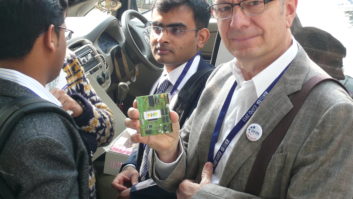Will AM stations in the United States soon be able to offer song and title artist information, like FM stations can with RDS?
We reported after the spring NAB Show that iBiquity Digital was working on a way for analog AMs to transmit such data to display as text on appropriately equipped analog receivers. Now, NAB’s FASTROAD technology development project has released iBiquity’s report on the concept.
Called the AM Digital Data Service, the technology supports delivery of low data-rate text — approximately 90 to 1000 bits per second — for analog AMs. Right now, AMs have no way of transmitting text data such as song title and artist. This technology could be integrated into future analog receivers.
The proposed system uses several building blocks from the AM IBOC standard, though it’s not meant to be a full digital system. The ADDS is meant to transmit text data only and not digital audio.
The exact equipment a station would need for the service hasn’t been determined; however NAB and iBiquity expect that ADDS offers stations a simpler and less-expensive way to provide a limited digital data service compared to a full-blown AM IBOC installation, according to NAB Science & Technology Senior Director of Advanced Engineering David Layer.
“Also, the requirements on the antenna system for ADDS would be the same as for analog AM and not the more stringent requirements of AM IBOC,” said Layer. “This is important because antenna tuning, getting systems from analog AM to HD Radio specs, has been one of the major tasks needed to get AM IBOC functioning.”
What’s the next step for the ADDS project? Layer said determining the level of interest among stations and receiver makers level of interest is key. Given sufficient interest the FASTROAD project may go to the next phase, implementation and testing.
Read the study here (PDF).












